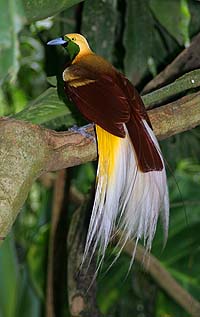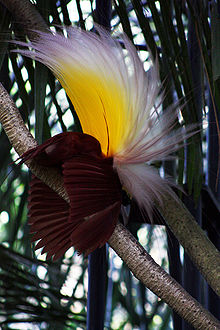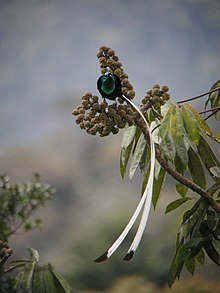From Wikipedia, the free encyclopedia
This article is about the bird family Paradisaeidae. For other uses, see Bird of paradise (disambiguation).
| Bird-of-paradise | |
|---|---|
 | |
| Adult male Lesser Bird-of-paradise, Paradisaea minor | |
| Scientific classification | |
| Kingdom: | Animalia |
| Phylum: | Chordata |
| Class: | Aves |
| Order: | Passeriformes |
| Suborder: | Passeri |
| Family: | Paradisaeidae Vigors, 1825 |
| Genera & Species | |
| 14 Genera 40 Species | |
The family is of cultural importance to the inhabitants of New Guinea. The trade in skins and feathers of the birds-of-paradise has been going on for two thousand years; and, the birds have been of considerable interest to Western collectors, ornithologists and writers as well. A number of species are threatened by hunting and habitat loss.
Contents[hide] |
[edit] Description
Birds of paradise are generally crow-like in general body-form, and, indeed, are the brother group to the corvids (crows and jays). Birds-of-paradise range in size from the King Bird-of-paradise at 50 g (1.8 oz) and 15 cm (5.9 in) to the Curl-crested Manucode at 44 cm (17 in) and 430 g (15 oz). The male Black Sicklebill, with its long tail, is the longest species at 110 cm (43 in). In all the males are larger and longer than the female, the differences ranging from slight to extreme. The wings are rounded and in some species structurally modified on the males in order to make sound. There is considerable variation in the family with regard to bill shape. Bills may be long and decurved, as in the sicklebills and riflebirds, or small and slim like the Astrapias. As with body size on average bill size varies with sex, although species where the females have larger bills than the male are more common, particularly in the insect eating species.[1]Plumage variation between the sexes is closely related to breeding system. The manucodes and Paradise-crow, which are socially monogamous, are sexually monomorphic. So are the two species of Paradigalla, which are polygamous. All these species have generally black plumage with varying amounts of green and blue iridescence.[1]
[edit] Habitat and distribution

Brown Sicklebills are montane species
The majority of birds-of-paradise live in tropical forests, including rainforest, swamps and moss forest.[1] Several species have been recorded in coastal mangroves.[2] The southernmost species, the Paradise Riflebird of Australia, lives in sub-tropical and temperate wet forests. As a group the manucodes are the most plastic in their habitat requirements, with in particular the Glossy-mantled Manucode inhabiting both forest and open savanna woodland.[1] Mid-montane habitats are the most commonly occupied habitat, with thirty of the forty species occurring in the 1000–2000 m altitudinal band.[2]
[edit] Behaviour
[edit] Diet and feeding

Male Greater Bird-of-paradise displaying
[edit] Breeding
Most species have elaborate mating rituals, with the Paradisaea species using a lek-type mating system. Others, such as the Cicinnurus and Parotia species, have highly ritualised mating dances. Males are polygamous in the sexually dimorphic species, but monogamous in at least some of the monomorphic species. Hybridisation is frequent in these birds, suggesting the polygamous species of bird of paradise are very closely related despite being in different genera. Many hybrids have been described as new species, and doubt remains regarding whether some forms, such as Rothschild's Lobe-billed Bird of Paradise, are valid.[citation needed] Despite the presence of hybrids, some ornithologists hypothesise that at least some putative hybrids are valid species that may be extinct.[3]Birds-of-paradise build their nests from soft materials, such as leaves, ferns, and vine tendrils, typically placed in a tree fork.[4] Clutch size is somewhat uncertain. In the large species, it is almost always just one egg. Smaller species may produce clutches of 2–3.[5] Eggs hatch after 16–22 days, and the young leave the nest at between 16 and 30 days of age.[4]
[edit] Taxonomy and systematics
For many years the birds-of-paradise were treated as being closely related to the bowerbirds. Today while both are treated as being part of the Australasian lineage Corvida, the two are now only thought to be distantly related. The closest evolutionary relatives of the birds-of-paradise are the crow and jay family Corvidae, the monarch flycatchers Monarchidae and the Australian mudnesters Struthideidae.[1]A 2009 study examining the mitochondrial DNA of all species to examine the relationships within the family and to its nearest relatives estimated that the family emerged 24 million years ago, older than previous estimates had estimated. The study identified five clades within the family, and placed the split between the first clade, which contains the monogamous manucodes and Paradise-crow, and all the other birds-of-paradise, to be 10 million years ago. The second clade includes the parotias and the King of Saxony Bird-of-paradise. The third clade provisionally contains a number of genera, Seleucidis, the Drepanornis sicklebills, Semioptera, Ptiloris and Lophorina, but support values for some of these is inclusions is low. The fourth clade includes the Epimachus sicklebills, Paradigalla and the astrapias. The final clade includes the Cicinnurus and the Paradisaea birds-of-paradise.[6]
The exact limits of the family have been the subject of revision as well. The three species of satinbird (the genera Cnemophilus and Loboparadisea) were treated as a subfamily of the birds-of-paradise, Cnemophilinae. In spite of differences in the mouth, foot morphology and nesting habits they remained in the family until a 2000 study moved them to a separate family closer to the berrypeckers and longbills (Melanocharitidae).[7] The same study found that the Macgregor's Bird-of-paradise was actually a member of the large Australasian honeyeater family. In addition to these three species, a number of systematically enigmatic species and genera have been considered potential members of this family. The two species in the genus Melampitta, also from New Guinea, have been linked with the birds-of-paradise,[8] but their relationships remain uncertain, more recently being linked with the Australian mudnesters.[1] The Silktail of Fiji has been linked with the birds-of-paradise many times since its discovery, but never formerly assigned to the family. Recent molecular evidence now places the species with the fantails.[9]

No comments:
Post a Comment